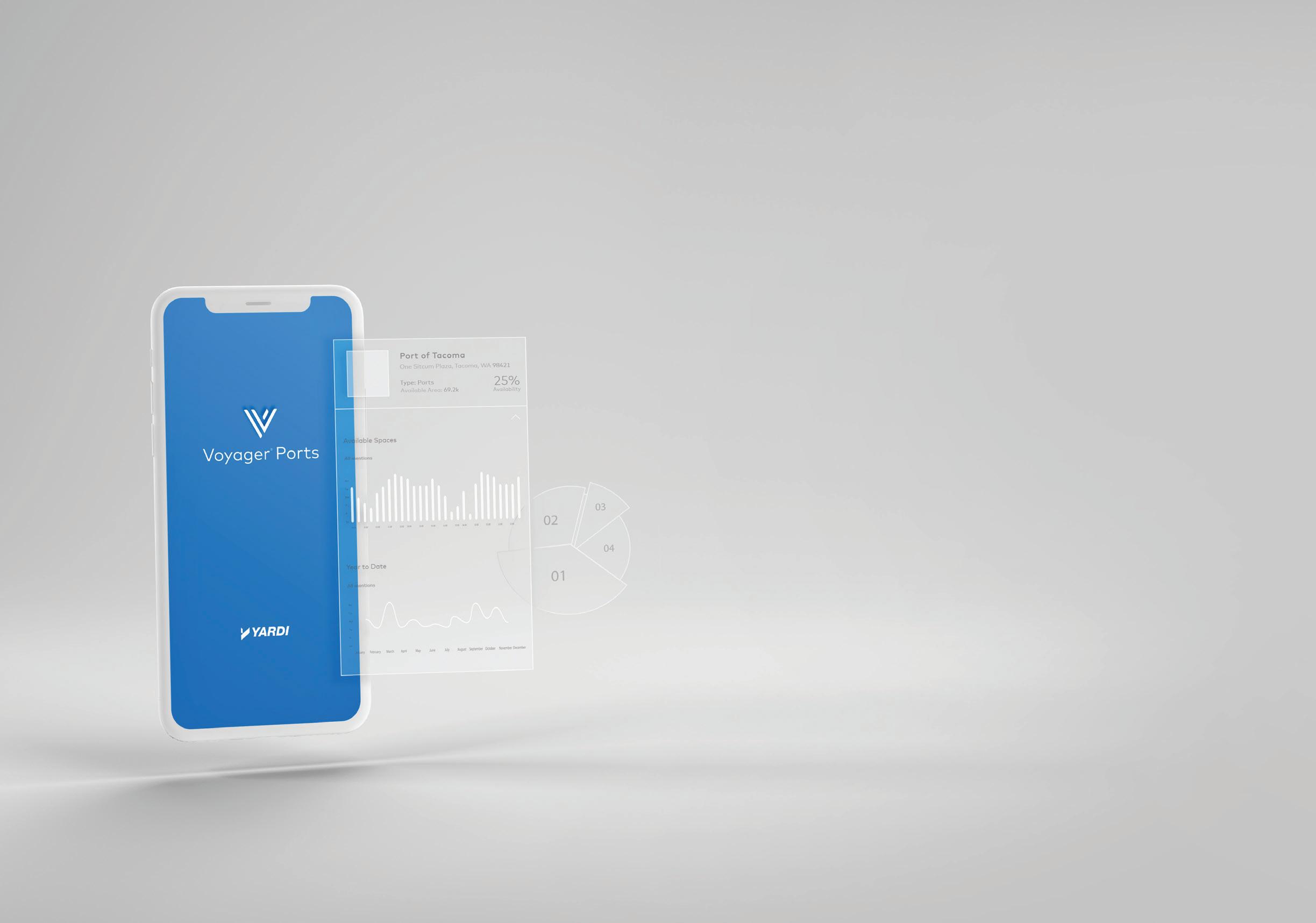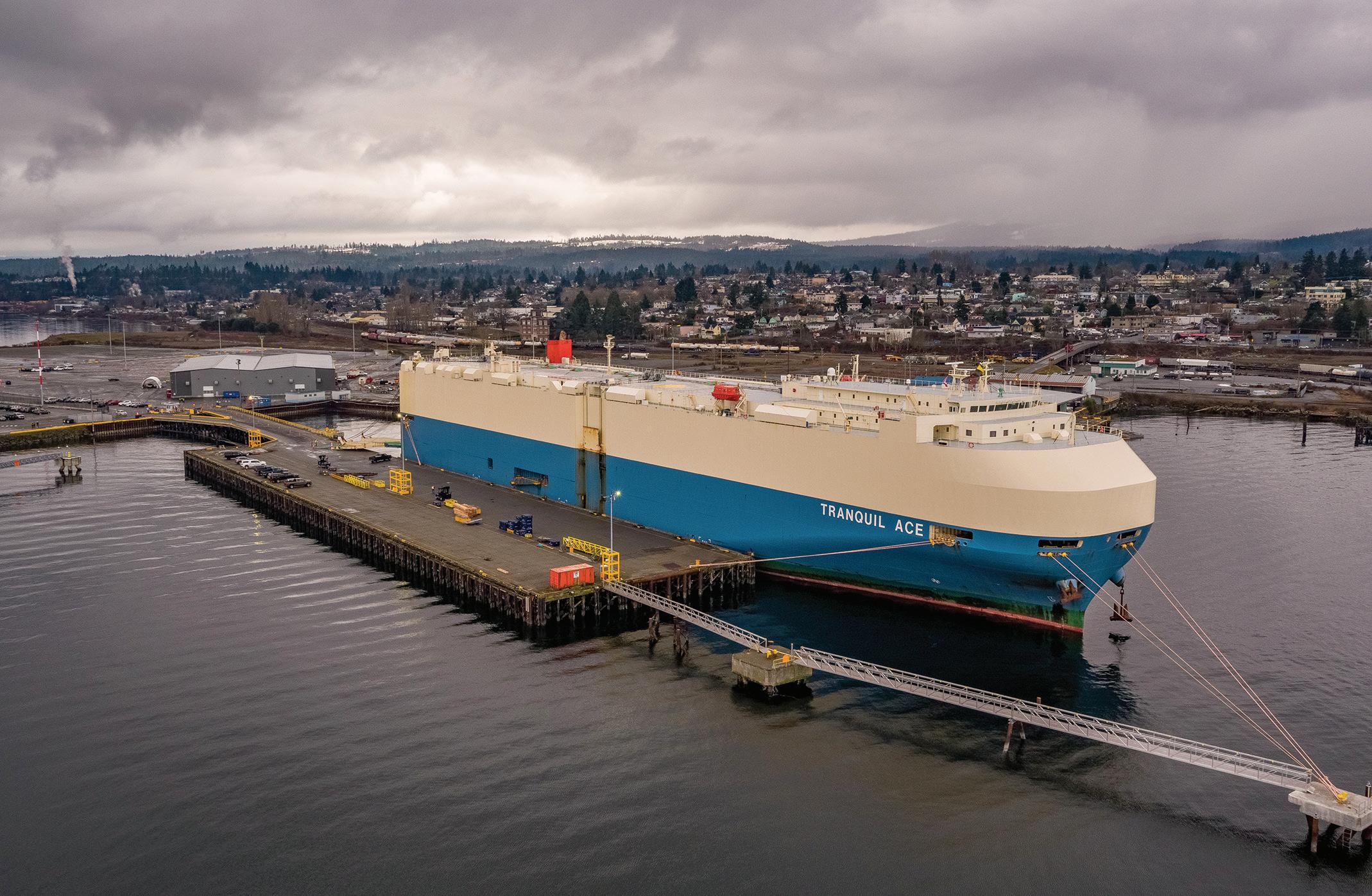
8 minute read
COMPETITIVE TRADE
:
By Darryl Anderson, Managing Director Wave Point Consulting, Hanh Le-Griffin Director, Ports & Marine Terminals Hatch Engineering, and Phil Davies Principal, Davies Transportation Consulting Inc.
Shifting economic conditions, customer expectations, the emergence of new technologies and environmental regulations are constant pressures facing ports and their customers. Moreover, confronting logistics and transportation challenges is required for increased port and regional trade competitiveness. During this heightened uncertainty and renewed optimism, insights are needed now more than ever to navigate the currents in a rapidly changing post-COVID world.
Maritime cargo and industry trends
In the container sector, the 2008 recession had long-term impacts on North American container intermodal traffic. United States ports saw a pronounced shift from international (IPI) traffic to domestic (transloaded) traffic for ocean imports. IPI traffic did not recover until 2018. The impact of the change since the start of COVID on the major gateways is two-fold. Southwest (LA/Long Beach) and Northwest (Northwest Seaport Alliance) regional ports were affected by stagnation in the IPI market and rising Western Canadian (Prince Rupert and Vancouver) and Northeast (New York/New Jersey & Norfolk) regional market shares.
To date, the reaction to COVID disruptions has been a continuation of long-term trends in West Coast ports’ container market shares. However, there are also some record-breaking container traffic volumes at some ports as the pandemic lingers. In addition, following the onset of the COVID-19 disruptions, demand surges have arisen as various nations and regions cycle through the stages of lock-down or economic openings. As a result, there is port congestion, capacity constraints and record-high container ocean shipping rates.
Surging global container volumes has placed extreme pressure on supply chains. Several Pacific coast ports reached a critical point with an urgent requirement for near-dock storage space to relieve stress on maritime terminals. With some ports experiencing nearrecord or record import container volumes, improving cargo fluidity became critically important when the on-time service reliability of the container sector deteriorated.
Infrastructure gaps were exposed by COVID-induced shipping congestion. The local conditions at each port are driving the need for these facilities. In 2020, a surge yard last opened at Pier S in Long Beach. In addition, the Northwest Seaport Alliance (NWSA) of Seattle and Tacoma is opening a second surge yard for beneficial cargo owners, container lines, and terminal operators who need logistics facilities to store containers and chassis temporarily. In the quest to find a suitable location, operators of surge yards are exploring sites that are preferably served by rail, whether with a Class 1 railway carrier and inland or major inland rail gateways such as Chicago.
Photo source: Port of Long Beach

Break-bulk and project cargo outlook is rising as we enter more fully into an emerging post-pandemic world. Renewable energy, oil, gas and infrastructure projects, and an unbalanced container shipping supply chain combine to demand. However, vessel routing, port congestion, rising rates, truck, equipment, and driver shortages complicate the inland movement of cargo.
The auto industry continues to grapple with ongoing supply chain as aggregates and limestone are likely to help fuel the market. However, geopolitical tension, trade irritants (especially in the agricultural sectors), economic growth, the capacity of logistics infrastructure, the impact of COVID on crew changes and vaccination levels in importing countries creates ongoing challenges and port congestion.
New research from brokers Braemar ACM reveals that more dry bulk shipments are impacted by port congestion than ever before. Therefore, the demands placed on port and government officials to quickly find suitable vessel anchorage locations to deal with vessel congestion and maintain support from coastal communities are not without challenges.
A key question for port officials to answer is how to enhance port and regional trade competitiveness in an emerging post-COVID world. Answers to this question will play out differently for major ports and gateways compared to regionally significant ports.
Logistics practices and infrastructure
The cargo types, volume and traffic density that characterize the major ports and gateways suggest that the mid-term outlook is for continued intense pressure on port-related logistics infrastructure to improve fluidity and heightened public concern for ports to deal with the environmental impacts of cargo traffic.
There will also be a continuing need for more warehouses and distribution centers near large ports and urban areas. Solutions to meet the logistics demands generated by truck trips and the need to deal with congestion are paramount. Enhancing the supply chain resiliency at major ports involves developing near-dock support facilities, the use of information systems and security in the mid-term.
While the commercial behavior of Class 1 railways greatly influences the competitive position of gateway ports, supply chain resiliency for both bulk
issues, most notably a shortage of semiconductors, steel shortages, backlogs at ports, etc. The sector is seeing the most significant challenges to their supply chain that they have experienced in decades. The implication is that delayed demand will put more pressure on logistics and transport systems going forward.
The dry bulk sector market shows optimism because commodities such as iron ore and coal, and minor bulks such
SHIPPING SOLUTIONS AT TWO DEEP SEA TERMINALS LINKING VANCOUVER ISLAND’S ECONOMY TO THE WORLD.

• The Port of Nanaimo ships 18 different Vancouver Island products to 25 ports in 14 countries. • Short-sea shipping to Vancouver with capacity to handle containers, bulk, break bulk, heavy lift and project cargoes. • Enhanced infrastructure providing versatility and efficiencies for diverse cargo and vessel solutions and to meet a growing container business both locally and globally.
LOCAL BENEFITS — GLOBAL REACH
For Cargo and Terminal oppportunities, please contact: Jason Michell, VP - B.D. (250) 734-3457 JMichell@npa.ca

www.npa.ca 100 PORT DRIVE, NANAIMO, BC

and containerized cargo is impacted by events causing disruptions to rail service far beyond the maritime terminal. For example, in early July, a small British Columbia community fire damaged two nearby tracks operated by Canadian Pacific Railway Ltd. and Canadian National Railway Co.
While Canadian railways have long had winter operating plans, and ports have procedures to deal with weather events, the fire in the interior of B.C. makes one wonder if proactively dealing with the possible impacts of wildfires need to become part of industry’s best practices.
Due to a record heatwave, the Canadian Federal Transport Minister ordered a 48-hour stop to rail transport in parts of British Columbia and also ordered other precautions against wildfires, including reduced train speeds. While the order was put in place as an interim measure, officials have been working with railway companies to permanently incorporate these fire risk reduction measures.
While coastal and logistics facility resiliency planning will increase in importance over the longer term, the long lead time for infrastructure approval required for port modernization means that specific issues must be addressed. The design of new facilities to ensure the resiliency of ongoing operations from the impacts of sea-level rise must be considered. However, due to the long-term nature of the problem, retrofitting existing facilities is not typically worthwhile.
Following the disruption of port operations by Hurricane Sandy in 2012, the Port Authority of New York/New Jersey issued Climate Resilience Design Guidelines. The guidelines incorporate climate change projections (particularly sea-level rise) into the full range of port authority engineering and architectural design standards to supplement applicable building code requirements.
For regionally significant ports, an important question to ask is whether cargo congestion can generate growth opportunities. In some instances, worldwide port congestion and supply chain interruptions can lead to opportunistic
Streamline your financial and real estate portfolio management
Maximize leasing efficiency Automate port charges and receivables Redefine document management

LEARN MORE
(800) 866-1144 Yardi.com/Ports
cargo growth at regionally significant ports. For example, in June 2021, 140 containers were barged from Seattle’s T30 pier to Fraser Surrey Docks. In July, the Port of Everett received the breakbulk cargo ship Eemslift Nadine that was carrying 64 import containers for Rad Power. While Rad Power chartered the Eemslift Nadine, available cargo space was shared with a machinery company whose cargo will be unloaded at Long Beach. Also, Rad Power had to arrange to purchase containers outright, rather than using containers that were owned by the shipping company.
New infrastructure investment requires consistent baseload cargo flow to improve project economics. Examples include the Port of Nanaimo Vehicle Processing Centre and the Port of Hueneme expanding cold chain facility and agriculture trade. In late 2020, the Port of Hueneme was the first U.S. Pacific Coast port to provide on-dock cold treatment that allowed it to bring in blueberries from Peru under a pilot program. Project success required collaboration with the USDA, CDFA, and Ventura County Agricultural Commissioner. In early September, a leading real estate firm, NorthPoint Development, and The Port of Coos Bay signed a Memorandum of Understanding to create a multimodal container facility on the North Spit of Coos Bay. The parties estimate the facility will move more than one million 40-foot containers a year using the Coos Bay Rail Line.
For regionally significant ports, operations are business development. Therefore, simplifying governance and resolving the question of who has the authority to effectively make commercial and operational decisions to deal with rapid changes in the marketplace that are essential as infrastructure development.
Conclusion
The takeaway message is that port authority officials, BCOs, logistics service providers, and shipping companies must deal with the short and mid-term cargo needs related to congestion issues. However, it is also becoming increasingly apparent that commercial and environmental pressures will require executive leadership and stakeholder collaboration: made even more challenging by COVID19 public health requirements. Whether maritime industry officials, governments and stakeholders have the time and energy to address both short-term and long-term needs essential for regional trade competitiveness remains to be seen. With the right focus, people, and technical resources we remain confident that the maritime logistics sector can contribute to robust and sustainable improvements that benefit everyone engaged in international trade and the communities across the nations we exist to serve.











